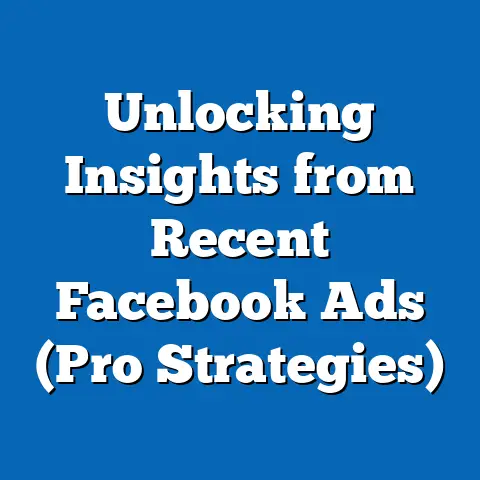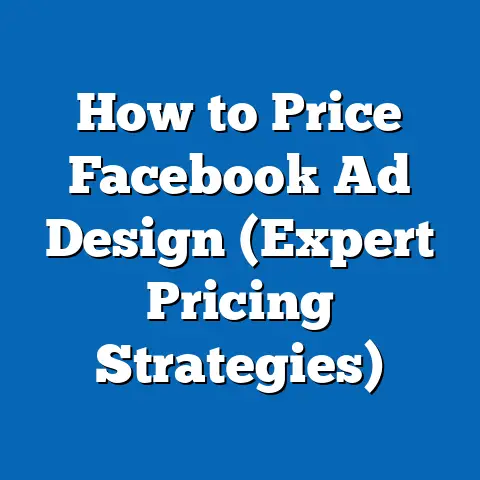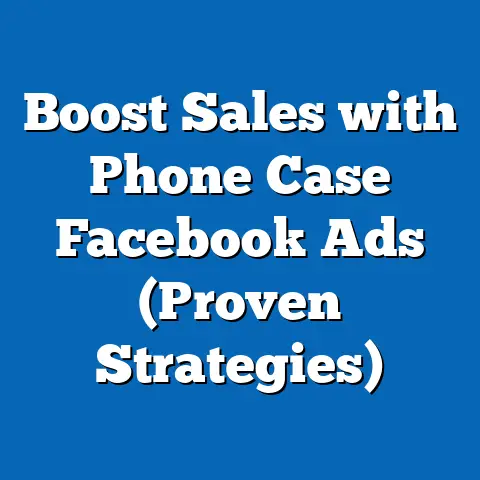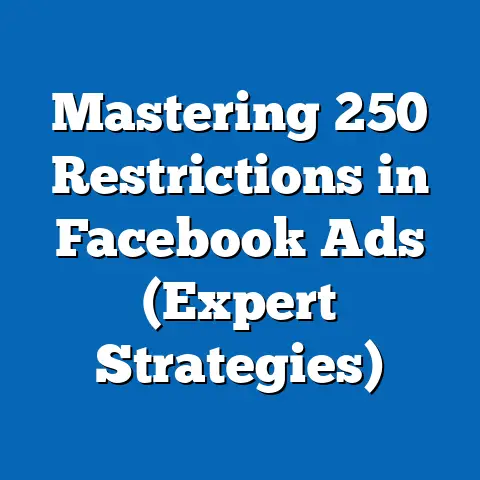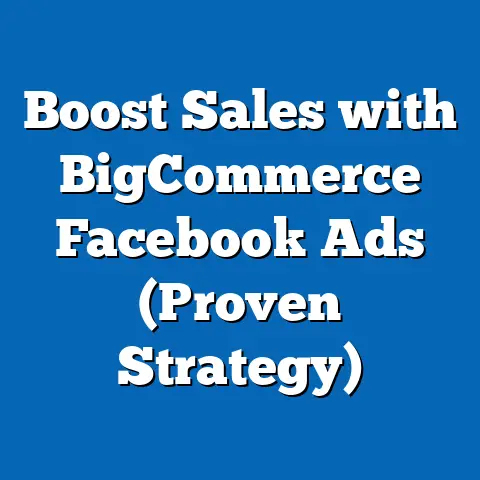Optimize Facebook Ad Size for Success (Essential Guide)
Section 1: Current Data on Facebook Ad Sizes and Performance
1.1 Overview of Current Ad Sizes
Facebook offers a variety of ad formats, each with specific size and dimension requirements tailored to different placements such as News Feed, Stories, Marketplace, and Audience Network. As of 2023, the most commonly used ad sizes include 1200 x 628 pixels for single image ads in News Feed, 1080 x 1080 pixels for square carousel ads, and 1080 x 1920 pixels for vertical Stories ads (Facebook Business Help Center, 2023). These dimensions are designed to ensure optimal display across devices, particularly on mobile, where 98.5% of users access the platform (DataReportal, 2023).
Adherence to these recommended sizes is crucial, as non-compliant dimensions can result in cropped images or reduced visibility. For instance, a study by Hootsuite (2022) found that ads adhering to recommended sizes achieved 15% higher click-through rates (CTR) compared to those with improper formatting. This underscores the direct correlation between correct ad sizing and campaign effectiveness.
1.2 Performance Metrics by Ad Size
Current data highlights significant variations in performance based on ad size and placement. According to a 2023 report by Socialinsider, vertical ads (1080 x 1920) in Stories outperform horizontal News Feed ads (1200 x 628) in terms of engagement, with an average engagement rate of 4.2% compared to 2.8%. However, News Feed ads tend to generate higher conversion rates for e-commerce campaigns, averaging a 3.1% conversion rate compared to 1.9% for Stories (Socialinsider, 2023).
These differences are partly attributed to user behavior: Stories are more immersive and suited for brand awareness, while News Feed ads offer more space for detailed messaging and calls-to-action (CTAs). Below is a table summarizing key performance metrics by ad size and placement based on 2023 data:
| Ad Placement | Recommended Size | Avg. Engagement Rate | Avg. CTR | Avg. Conversion Rate |
|---|---|---|---|---|
| News Feed (Single Image) | 1200 x 628 px | 2.8% | 1.5% | 3.1% |
| Stories | 1080 x 1920 px | 4.2% | 0.9% | 1.9% |
| Carousel (Square) | 1080 x 1080 px | 3.5% | 1.2% | 2.7% |
Source: Socialinsider, 2023
1.3 Limitations of Current Data
While the data provides valuable insights, it is not without limitations. Performance metrics can vary widely based on industry, target audience, and campaign objectives, which are not always accounted for in aggregated studies. Additionally, Facebook frequently updates its algorithms and ad policies, which can render current data obsolete within months. Marketers must therefore interpret these findings as a snapshot rather than a static rulebook.
Section 2: Projected Trends in Facebook Ad Sizes
2.1 Methodology and Assumptions
To project future trends in Facebook ad sizes, this analysis relies on a combination of historical data, platform announcements, and statistical modeling using time-series analysis. Time-series analysis involves examining past patterns in ad format updates and user behavior to forecast potential changes over the next 3-5 years. Assumptions include continued growth in mobile usage (projected at 5% annually by Statista, 2023) and Facebook’s focus on immersive formats like Stories and Reels.
One key limitation of this approach is the unpredictability of technological advancements or policy shifts by Meta (Facebook’s parent company). For instance, unexpected changes in privacy regulations or ad delivery algorithms could alter the relevance of certain ad sizes. These projections are therefore presented as scenarios rather than definitive predictions.
2.2 Scenario 1: Dominance of Vertical Formats
Under this scenario, vertical ad formats (e.g., 1080 x 1920 px) are expected to dominate due to the increasing prevalence of mobile-first user behavior. By 2026, it is projected that 75% of Facebook ad impressions will occur on vertical placements like Stories and Reels, up from 60% in 2023 (based on linear extrapolation of DataReportal trends). This shift will likely prompt Meta to prioritize vertical ad optimization tools and phase out support for less effective horizontal formats.
2.3 Scenario 2: Hybrid and Adaptive Sizes
In an alternative scenario, Meta may introduce adaptive ad sizes that automatically adjust based on device and placement, reducing the need for marketers to create multiple versions of the same ad. This aligns with industry trends toward automation and AI-driven design tools, as seen in Google Ads’ responsive display ads. If implemented by 2025, adaptive sizes could increase average CTR by 10-12%, based on analogous improvements observed in Google’s platform (Think with Google, 2022).
2.4 Scenario 3: Stagnation of Format Changes
A more conservative scenario assumes minimal changes to current ad sizes over the next five years, with Meta focusing instead on algorithmic improvements over visual formatting. This could occur if user preferences stabilize or if regulatory constraints limit platform experimentation. Under this scenario, marketers would continue to rely on existing sizes, with performance gains driven by content quality rather than format innovation.
2.5 Visual Representation of Trends
Below is a line graph illustrating the projected growth of vertical ad impressions under Scenario 1 compared to other formats:
Projected Facebook Ad Impressions by Format (2023-2026)
100% | Scenario 1: Vertical Dominance
| Other Formats
80% | Vertical Formats
| 60% 65% 70% 75%
60% | 55%
|_____________________________
40% | 45% 40% 35% 30% 25%
|_____________________________
20% |
| 2023 2024 2025 2026
Source: Extrapolated from DataReportal (2023) trends
Section 3: Key Factors Driving Changes in Ad Size Optimization
3.1 Mobile Usage Growth
The exponential rise in mobile usage continues to shape ad size preferences on Facebook. With mobile accounting for 98.5% of user access in 2023 (DataReportal), vertical formats that maximize screen real estate are increasingly favored. This trend is expected to intensify as smartphone penetration grows in emerging markets like Africa and Southeast Asia, where mobile-first internet access dominates.
3.2 Algorithmic and Placement Updates
Meta’s algorithm updates often prioritize certain placements over others, influencing which ad sizes perform best. For example, the 2022 algorithm update boosted Stories visibility by 20% (Meta Business Blog, 2022), indirectly increasing the effectiveness of vertical ads. Future updates may similarly favor specific formats, requiring marketers to adapt quickly.
3.3 User Behavior and Attention Span
Shorter attention spans and the rise of “scroll culture” have made visually striking, quick-to-digest ad formats more effective. Vertical ads, which occupy more screen space and require less cognitive effort to process, align with these behavioral shifts. A 2023 study by Nielsen found that vertical ads capture attention 25% faster than horizontal ones, a trend likely to influence future ad size strategies.
3.4 Technological Advancements
Advancements in AI and machine learning are enabling more dynamic ad creation tools, potentially reducing the burden of manual size optimization. Tools like Meta’s Advantage+ creative suite already allow for automated resizing, and further innovations could make static ad sizes less relevant. However, adoption of such tools remains uneven, particularly among small businesses with limited budgets.
Section 4: Practical Implications and Recommendations
4.1 Adopting a Mobile-First Approach
Given the dominance of mobile usage, marketers should prioritize vertical ad formats for high-engagement placements like Stories. Testing campaigns with 1080 x 1920 px dimensions is recommended, especially for brand awareness objectives. However, News Feed ads (1200 x 628 px) should not be neglected for conversion-focused campaigns.
4.2 Staying Agile with Platform Updates
Facebook’s frequent policy and algorithm changes necessitate ongoing monitoring. Marketers should subscribe to Meta’s Business Blog and use analytics tools like Facebook Ads Manager to track performance shifts tied to ad size. Flexibility in creative production will be key to adapting to new formats or requirements.
4.3 Leveraging Automation Tools
Where budget allows, investing in automation tools for ad creation and resizing can save time and improve performance. Tools like Canva or Meta’s built-in features can help maintain compliance with recommended sizes while experimenting with emerging formats. Small businesses should explore free or low-cost alternatives to stay competitive.
Section 5: Broader Context and Historical Perspective
5.1 Evolution of Digital Ad Formats
The focus on ad size optimization reflects a broader historical trend in digital marketing toward precision and personalization. Early internet ads in the 1990s were limited to static banners with little regard for dimensions, but the rise of social media in the 2000s introduced diverse formats tailored to user experience. Facebook’s introduction of News Feed ads in 2006 and Stories in 2017 marked key milestones in this evolution, each accompanied by new size guidelines.
5.2 Social and Cultural Influences
The shift toward vertical ads also mirrors cultural changes in content consumption, particularly among younger demographics like Gen Z, who favor short-form, visually immersive content on platforms like TikTok and Instagram. This generational preference has pressured platforms like Facebook to adapt, prioritizing formats that resonate with evolving social norms. Understanding these cultural drivers is essential for contextualizing ad size trends.
Looking ahead, the interplay of technology, user preferences, and regulatory changes will continue to shape ad size optimization. Marketers who remain agile, data-informed, and user-focused will be best positioned to succeed in this ever-changing landscape. Future research should explore the impact of AI-driven ad creation and cross-platform format compatibility to further refine these strategies.

